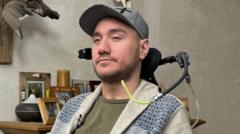Noland Arbaugh, the first recipient of Neuralink's brain-computer interface, demonstrates both the potential and challenges of this groundbreaking technology.
**Brain-Machine Interfaces: A New Era of Empowerment for the Paralyzed**

**Brain-Machine Interfaces: A New Era of Empowerment for the Paralyzed**
A revolutionary brain chip developed by Neuralink offers newfound independence to paralyzed individuals, sparking ethical questions.
Noland Arbaugh, a 30-year-old from Arizona, has recently become the first individual to receive a brain-computer interface (BCI) implant from Neuralink, the neurotechnology company founded by Elon Musk. After being paralyzed below the shoulders due to a diving accident in 2016, Noland's journey represents a significant milestone in the nexus of science and technology.
The device enables him to control a computer purely through thoughts, translating neuronal spikes into digital commands. Noland’s innovative experience raises awareness and excitement about the future of neurotechnology, where individuals with severe disabilities could regain autonomy in their daily lives. However, this advanced technology also brings forth concerns regarding privacy and ethical implications.
Speaking to BBC, Noland expressed his motivation for participating in the experiment, stating that his involvement would contribute to advancing the science behind BCIs. "Good or bad, whatever may be, I would be helping," Noland remarked. Despite acknowledging the potential risks, he emphasized the importance of the progress being made.
The device’s initial success has proven transformative for Noland, allowing him not only to interact with a computer cursor but also to play games he once relished, such as chess. This return to gaming symbolizes hope for paralyzed individuals and underscores the transformative possibilities of BCIs.
However, researchers and experts highlight challenges linked to the technology. Privacy concerns arise as brain activity could potentially be accessible, raising significant questions about mental autonomy. Neuroethics professor Anil Seth cautions that the implications of accessing thoughts may complicate our understanding of personal privacy.
Other companies, like Synchron, are also pioneering BCI technology with less invasive methods, such as their Stentrode device, which can be implanted through blood vessels rather than traditional open brain surgery. For users, these advancements could open avenues to experience virtual environments, providing a sense of mobility and engagement previously thought impossible.
While Noland looks forward to further improvements, expressing hope that his device could eventually enable him to control a wheelchair or even a humanoid robot, a cloud of uncertainty remains after a six-year study period linked to his implant. Despite the hurdles, Noland’s experience exemplifies how BCI technology continues to push the boundaries of what is possible for individuals with disabilities, igniting discussions surrounding the future of neurotechnology and its ethical frameworks.
As this frontier of science expands, Noland Arbaugh’s story serves as both inspiration and a reminder of the delicate balance between innovation and ethical responsibility in the age of advanced neurotechnology.
The device enables him to control a computer purely through thoughts, translating neuronal spikes into digital commands. Noland’s innovative experience raises awareness and excitement about the future of neurotechnology, where individuals with severe disabilities could regain autonomy in their daily lives. However, this advanced technology also brings forth concerns regarding privacy and ethical implications.
Speaking to BBC, Noland expressed his motivation for participating in the experiment, stating that his involvement would contribute to advancing the science behind BCIs. "Good or bad, whatever may be, I would be helping," Noland remarked. Despite acknowledging the potential risks, he emphasized the importance of the progress being made.
The device’s initial success has proven transformative for Noland, allowing him not only to interact with a computer cursor but also to play games he once relished, such as chess. This return to gaming symbolizes hope for paralyzed individuals and underscores the transformative possibilities of BCIs.
However, researchers and experts highlight challenges linked to the technology. Privacy concerns arise as brain activity could potentially be accessible, raising significant questions about mental autonomy. Neuroethics professor Anil Seth cautions that the implications of accessing thoughts may complicate our understanding of personal privacy.
Other companies, like Synchron, are also pioneering BCI technology with less invasive methods, such as their Stentrode device, which can be implanted through blood vessels rather than traditional open brain surgery. For users, these advancements could open avenues to experience virtual environments, providing a sense of mobility and engagement previously thought impossible.
While Noland looks forward to further improvements, expressing hope that his device could eventually enable him to control a wheelchair or even a humanoid robot, a cloud of uncertainty remains after a six-year study period linked to his implant. Despite the hurdles, Noland’s experience exemplifies how BCI technology continues to push the boundaries of what is possible for individuals with disabilities, igniting discussions surrounding the future of neurotechnology and its ethical frameworks.
As this frontier of science expands, Noland Arbaugh’s story serves as both inspiration and a reminder of the delicate balance between innovation and ethical responsibility in the age of advanced neurotechnology.



















